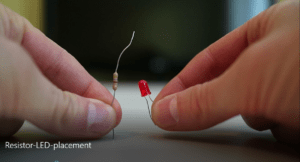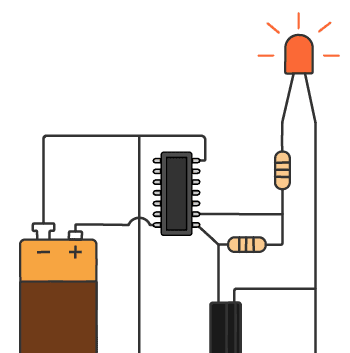
I remember something I struggled with in the beginning.
The LED.
It’s supposed to have a fixed voltage drop, right?
Like 2V.
But what if I force 3V across its legs with a 3V battery?
The LED seem to still work.
But does it now have 3V across its legs?
This is where it’s good to know how a real-world battery actually works.

Free Course: Blinking a Light
Join my free email course on how to build a circuit that blinks a light. Enter your details below and you'll receive the first lesson right away:
A real-world battery will have internal resistance.
So when you connect a battery directly to an LED, you actually have a resistor in series with the LED.
It’s just inside the battery.
And this resistor is usually very small.
Maybe 20 ohms.
So what happens is that the LED still gets 2V across it.
And 1V drops across the internal 20-ohm resistor instead.
1V across 20 ohms gives a current of 50 mA.
So you get 50 mA through your LED.
Too much for most standard LEDs.
Probably enough to reduce the lifetime of the LED multiple times.
But not too much to make it burn and die in a spectacular way.
Keep On Soldering!
Oyvind @ build-electronic-circuits.com
PS! Are you interested in learning electronics in a fun and practical way? I’ve created lots of courses on everything from basic electronics to how to build a kitchen timer. All available at Ohmify. Learn more here:
More Mail Archive Tutorials

10 Simple Steps to Learn Electronics
Electronics is easy when you know what to focus on and what to ignore. Learn what "the basics" really is and how to learn it fast.
